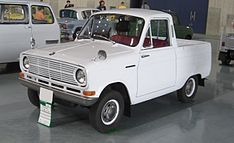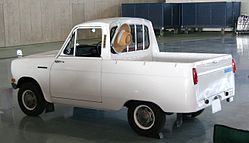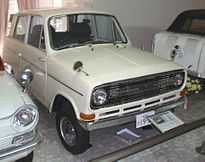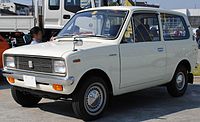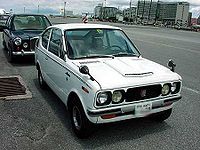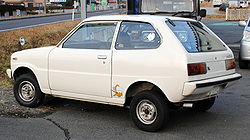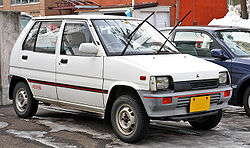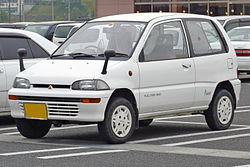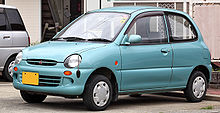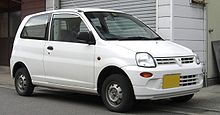- Mitsubishi Minica
-
Mitsubishi Minica 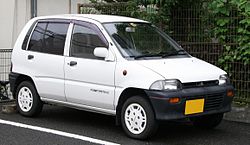
Fifth generation MinicaManufacturer Shin Mitsubishi Heavy-Industries (1962–64)
Mitsubishi Motors (1964–present)Also called Mitsubishi 360, Towny Production 1962–present Assembly Mizushima plant, Kurashiki, Okayama Class Kei car Related Mitsubishi Minicab The Mitsubishi Minica is a kei car produced by Mitsubishi Motors for the Japanese domestic market since October 1962. It was first built by Shin Mitsubishi Heavy-Industries, one of Mitsubishi Heavy Industries' three regional automotive companies until they were merged in 1964. It is the oldest Mitsubishi passenger car still in production, and the only one which predates the company itself.
Contents
First Generation
Mitsubishi 360
Mitsubishi 360 (commercials) 
Production 1961–69 Body style 2-door Panel van (LT20)
2-door light van (LT21/23)
2-seat pickup truck (LT22/25)Layout Front engine, rear-wheel drive Engine ME21/ME24/ME24D 359 cc air-cooled two-stroke I2
ME21: 17 PS at 4,800 rpm
ME24: 18 PS at 4,800 rpm
ME24D: 21 PS at 5,500 rpmWheelbase 1,900 mm (74.8 in) Length 2,995 mm (117.9 in) Width 1,295 mm (51.0 in) Height 1,390–1,400 mm (54.7–55.1 in) Curb weight 480–525 kg (1,058–1,157 lb) The precursor of the Minica was the Mitsubishi 360, a series of light trucks introduced in April 1961. Designed for the lowest kei car vehicle tax classification, it was powered by an air-cooled 359 cc, 17 PS (13 kW) engine, providing a lowly 80 kilometres per hour (50 mph) top speed but with a fully syncromeshed four-speed transmission. After the successful 1962 introduction of the passenger car version, called Minica, the 360 van and pickup continued alongside the Minica, sharing its development.[1] The Mitsubishi 360/Minica competed with the established Subaru 360, Daihatsu Fellow Max, and the Suzuki Fronte in the late sixties. The somewhat unexpected success of the 360/Minica led Mitsubishi to end production of three-wheeled vehicles.
Originally available as a panel van or light van (really a Station Wagon, but registered as a commercial vehicle for tax purposes), with a pickup version added in October, the Mitsubishi 360 was rather quaintly styled. Suicide doors and a swage line which continued across the hood were often accented by whitewall tires and lace curtains (both standard on the Light Van DeLuxe, introduced in April 1962) to complete the picture. The 360 and Minica were given a thorough facelift in November 1964, with an entirely new front clip with a pressed metal chrome grill (see picture of Minica Sedan below). The more modern look was accompanied by the new, somewhat more powerful ME24 engine, affording a top speed of 85 kilometres per hour (53 mph).[2]
In August 1966, the Mitsubishi Minicab cab-over pickup truck was launched to complement the Mitsubishi 360 light truck. Powered by the same air-cooled two-stroke 359 cc engine as the Minica, it came with cargo gates on three sides to simplify loading and unloading. In December, the 360 received a less ornate grille. In May 1967, the 360 and Minica were both updated with the new 21 PS ME24D, increasing top speed to 90 kilometres per hour (56 mph).[1] In September 1968 a Super Deluxe version of the light van was added, featuring a new plastic grille and more modern interior. By 1969, the Mitsubishi 360 was no longer produced.
Minica Sedan
1st generation 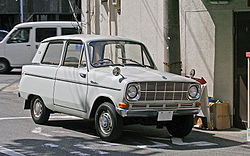
Production 1962.10–1969.07 Body style 2-door sedan Platform LA20/21/23 Engine ME21/ME24/ME24D 359 cc air-cooled two-stroke I2
2G10 359 cc two-stroke I2
ME21: 17 PS at 4,800 rpm
ME24: 18 PS at 4,800 rpm
ME24D: 21 PS at 5,500 rpm
2G10: 23 PS at 5,500 rpmThe first Minica (LA20) was first introduced in October 1962 as a two-door sedan based on the Mitsubishi 360 light truck, sharing its front-mounted ME21 359 cc twin cylinder air-cooled engine driving the rear wheels, transverse leaf springs in front and beam axle/leaf springs at the rear.[3] Top speed was marginally higher at 86 km/h (53 mph). With its tailfins and scalloped rear windshield, the Minica looked even more anachronistic than its van/pickup counterparts. In November 1964 the Minica (and 360) received a fairly thorough facelift and the improved ME24 engine (LA21). Power output was up by one, to 18 PS (13 kW), with the new "Auto Mix" system removing the need for premixing oil and gasoline.[4]
In December 1966, along with a slightly different grille and new badging, a basic "Standard" Minica sedan was added, while the regular version was promoted to "Deluxe". Prices were ¥340,000 and ¥368,000 respectively.[5]
In May 1967, the Minica was given another minor update, with a modified dashboard and a padded center to steering wheel. The engine was also upgraded, with the new reed valve ME24D providing a useful 21 PS.[6] In September of the following year, a Super Deluxe grade was added, using the new 23 PS (17 kW) water-cooled 2G10 engine developed for the next generation Minica.[4] This (the LA23) also featured a full vinyl interior and a new plastic grille (as on the Mitsubishi 360 van pictured above). With the July 1969 introduction of the second generation Minica, the LA series was discontinued.
Second generation
2nd generation 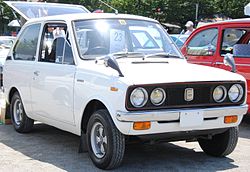
Production Sedan: 1969–73
Van: 1969-81
Skipper: 1971-74Body style 3-door sedan
2-door wagon
2-door coupéPlatform A100/100V・A101/101V・A102・A104V/105V・A106V Engine ME24E/F 359 cc air-cooled two-stroke I2
2G10 359 cc two-stroke I2[7]
2G21 359 cc SOHC I2Wheelbase 1,900 mm (74.8 in) Length 2,995 mm (117.9 in) Width 1,295 mm (51.0 in) Height 1,305–1,390 mm (51.4–54.7 in) Curb weight 445–490 kg (981–1,080 lb) The second generation Minica 70 was introduced in July 1969 with coil springs front and rear, a five-link rigid rear axle, and a three-door sedan body featuring the new "Wing-Flow Line" style. The new design was much more appealing to young buyers than the dated and corny looks of earlier Minicas, and the rear hatch was a Kei class first. Two 359 cc 2G10 water-cooled two-stroke powerplants were optionally available (A101), either the Red 28 PS (21 kW) engine (Super Deluxe, Sporty Deluxe) or the Gold engine fitted with twin SU carburetors developing 38 PS (28 kW). The Gold engine, introduced in December 1969, was fitted as standard to the SS and GSS sport models. The basic Standard and Deluxe versions (A100) were still fitted with the old 26 PS (19 kW) ME24E air-cooled engine Yellow engine, for a top speed of 105 kilometres per hour (65 mph).[8] A two-door wagon body was also added in December and was to remain in production until its eventual replacement by the Minica Econo in 1981. In October 1970 the ME24F Yellow engine gained four horsepower for a total of 30 PS (22 kW) while the Red engine went up to 34 PS (25 kW).[7] The GSS version gained integrated foglights and four round headlight, while the SS was discontinued. A luxurious GL version was also introduced.
In February 1971 a very minor facelift meant the car was now called Minica 71. In addition to more aggressive, wider taillights and some trim changes, one could now get the water-cooled 2G10 engine in the lower priced Family Deluxe.[9]
The Minica Skipper was introduced in May 1971 as a two-door coupé with liftable rear window, and a choice of Red or Gold 2G10 engines. The Skipper was available either as the S/L, L/L or GT. This also meant that the GSS sedan was becoming obsolete, as the focus of the sportier Minicas shifted to the coupé versions. Besides chassis and internals, the Skipper shared the front clip and lower doorpanels with the sedan.[10] By September, with the introduction of the Minica 72, the sedan versions were no longer available with the Gold engine. Changes were limited to a new grille, taillights (incorporating amber turnsignals) and a new dash similar to that of the Skipper.[11]
In October 1972 the 2nd generation Minica received its last facelift, becoming the Minica 73 to soldier on for another year as a low-cost alternative to the new F4. Sold either as a Standard or a Deluxe, only the de-tuned 31 PS (2G10-5) Red engine also used in the Van versions was now available, placing the "73" firmly at the bottom of the Minica lineup. There were no more air-cooled Minicas available. One year later, a Van Custom was added, with four headlights and more extensive equipment. In late 1974 or early 1975 the Van was updated to accept new larger license plates that were now required. The Van continued with the two-stroke 2G10-5 engine until being replaced by the bigger engined Minica 5 Van in May 1976.
Also in October 1972 the renamed Skipper IV (A102) received the new four-stroke 2G21 engine from the Minica F4, with either 32 or 36 PS.[12] A new F/L replaced the S/L in the lineup. Along with some safety improvements in October 1973 both engines were replaced by the 30 PS (22 kW) "Vulcan S" engine, as the Skipper IV lineup was further narrowed. The coupé continued in production until July (or perhaps December) 1974, but ever more strangled by emissions regulations its market had by then shrunk to almost nothing.
Third generation
3rd generation 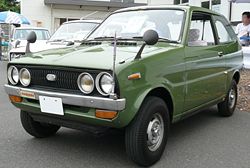
Production 1972–84 Body style 3-door sedan
2-door light vanPlatform A103A・A104A・A105A・A106A・A107A/V Engine 2G21 359 cc SOHC I2
2G22 471 cc SOHC I2
2G23 546 cc SOHC I2Wheelbase 2,000 mm (78.7 in) Length 2,995–3,175 mm (117.9–125.0 in) Width 1,295–1,395 mm (51.0–54.9 in) Height 1,315 mm (51.8 in) Curb weight 515–565 kg (1,140–1,250 lb) The third generation Minica was introduced as the Minica F4 (A103A) in October 1972 with a 359 cc OHC engine in the same layout, but featuring a liftable clam-shell rear window as on the coupé. The Skipper continued in production, as of October 1973 with the new engine (becoming the Minica Skipper IV). The new four-stroke Vulcan 2G21 MCA engine (Mitsubishi Clean Air) was much cleaner than, but not as smooth running as its two-stroke predecessors. The six single-carb engined versions provided 32 PS (24 kW) while the twin-carb version listed for the GS and GSL models offered 36 PS (26 kW).[12]
In late 1973, facing shrinking Kei-car sales, Mitsubishi narrowed the Minica F4 range down to four equipment levels (Hi-Standard, Deluxe, GL and SL), with the cheaper versions featuring a new grille. The sporty versions were discontinued, as the twin-carb engine fell foul of new emissions regulations. The modified Vulcan S engine came equipped with a balance shaft (later baptised "Silent Shaft") and was cleaner yet, hence the "MCA-II" tag. Power, however, was down to 30 PS. Top speed was 115 km/h (71 mph).[13] In December of 1974, the lineup was again revamped, with the GL and SL becoming the Super Deluxe and Custom.[14] Mitsubishi also lightly redesigned the Minica to accept the new, bigger license plates now required for Kei cars.
In May 1976, corresponding to revised kei car regulations of January 1976 (length up to 3.2 m, width to 1.4 m and engine size to 550 cc) both the sedan and the van received a new long-stroke 471 cc engine, a small increase in length (entirely due to new, larger bumpers), and a new name, the Minica 5. Both models were also lightly facelifted, featuring new grilles, while equipment levels remained the same. While power output of the new Vulcan 2G22 did not change for the sedan (A104A), the van (A104V) received a lower powered 28 PS (21 kW) version thereof. The Minica 5 was a mere interim model, anticipating the more thoroughly revised Minica Ami 55 which was soon to arrive.
Minica Ami
In June 1977 the car and engine grew once again, creating the Minica Ami 55. While the side body panels remained the same, length increased yet a little more (3175 mm) and the entire car was widened by 10 mm. The updated 546 cc Vulcan 2G23 engine provided 31 PS (23 kW) for the A105A. Its sibling, the Minica 55 Van (A105V) was updated in March 1977 and was almost impossible to distinguish from the previous Minica 5 Van, aside from badging and a slightly less plasticky front end. The bigger engine provided some useful additional torque, but the sporting Minicas of the early seventies were now but a memory. For the time being, the traditional (and unusual amongst Kei cars) Panhard layout remained.
September of 1978 brought another engine upgrade: The new "Vulcan II" G23B featured the lean burn MCA-Jet emissions control system with a hemispherical head, aluminium rocker arms and three valves per cylinder, but power outputs remained static. The model code became A106/106V.
In September 1981 the car received another redesign. An entire new rear end meant a slightly longer wheelbase (up to 2,050 mm) and a somewhat longer and taller body. The somewhat boxy rear end, still with a clamshell rear window, looked a bit incongruous paired with the original Minica F4 front wings and doors. The new Minica was renamed the Minica Ami L (A107A), but bigger news was that the Minica 55 Van, based on the 1969 A100V, was finally retired. The new A107V Minica Econo ("Econo" hinting at its primary use as a private economy car rather than as a commercial vehicle) looked very similar to the Ami L but featured a proper rear hatch and folding rear seat, allowing it to be registered as a light commercial vehicle like its competitors the Daihatsu Mira, Suzuki Alto and Subaru Rex. Cargo capacity, compared to the more workmanlike Minica 55 Van, was reduced from 300 to 200 kg. A 2-speed, semi-automatic gearbox was also available on all models, while the standard four-speed manual received lower gearing for the Econo model. The engine was more quiet than before, featuring a milder cam profile. Power output of the G23B remained the same, although the Econo was stuck with a 29 PS (21 kW) version of the old 2G23 engine. Top speed of the Ami was 110 km/h (68 mph).[15] In December 1981 a strict two-seater version of the Econo was added.
One year later, the Minica was sold with the new "MMC" logo rather than the old "three diamonds". In March 1983 the Minica Ami L Turbo became the first kei car to be offered with a turbocharger, offering 39 PS (29 kW) and glitzy graphics. This proved short-lived, as by January 1984 production of the A107 Minicas had ended, with Mitsubishi preparing for the release of an all new, front-wheel drive Minica.
Fourth generation
4th generation Production 1984–89 Platform H11A/V・H12V・H14A/V・H15A/V Engine G23B 546 cc SOHC I2
3G81 548 cc SOHC I3
2G25 783 cc SOHC I2
3G82 796 cc SOHC I3Wheelbase 2,260 mm (89.0 in) Length 3,195 mm (125.8 in) Width 1,395 mm (54.9 in) Height 1,420 mm (55.9 in) Curb weight 580 kg (1,300 lb) The fourth generation Minica was introduced in February 1984 as a front engined, front wheel drive vehicle for the first time. It offered three- and five-door configurations, increased size and a torsion beam/coil spring rear suspension. It retained the G23B engine, but modernized with a timing belt rather than the old noisy timing chain. The Minica sedan had 33 PS (24 kW), the Econo 31 PS (23 kW) and the Turbo gained an intercooler and now offered 42 PS (31 kW). Air conditioning finally became an option.
In September 1985 a four wheel drive model with a live rear axle was introduced. This generation was the first to reach export markets, usually labelled Mitsubishi Towny, originally with a two-cylinder 783 cc engine and a 4-speed manual transmission. Later (1987) it received a three cylinder 796 cc engine with 45 PS (33 kW) and a 5-speed gearbox (also locally manufactured by CMC motors in Taiwan, only as a 5-door); a three door panel van was also marketed abroad.
Fifth generation
5th generation Production 1989–93 Engine 3G81 548 cc I3
3G83 657 cc I3
3G83T 657 cc I3 turboWheelbase 2,260 mm (89.0 in) Length 3,195 mm (125.8 in) Width 1,395 mm (54.9 in) Height 1,420–1,515 mm (55.9–59.6 in) Curb weight 580–720 kg (1,300–1,600 lb) In January 1989 the fifth generation Minica was officially introduced, although the engine, wheelbase, and suspension remained unchanged. In addition to the three- and five-door models, a variant with a single door on the right side, two doors on the passenger side, and a liftgate was introduced, named the Mitsubishi Lettuce. An advanced new turbo engine with double overhead cams and the world's first mass-produced five valve per cylinder engine was introduced for the Dangan ZZ model, producing 64 PS (47 kW).[16][17] It was later made available in naturally aspirated form as well, while the older design engine also was increased in displacement to 657 cc in March, 1990 when the kei car regulations were again updated. A three door MPV model with optional four-wheel drive, the Minica Toppo, was introduced in 1990.
Sixth generation
In September, 1993, the sixth generation three and five door Minica and Minica Toppo were introduced, with longer wheelbase. The five valve per cylinder three cylinder engines were replaced with a pair of 659 cc four-cylinder engines; one normally aspirated with single overhead cam and four valves per cylinder, and one turbocharged with double overhead cam and five valves per cylinder. A version of the Toppo with two doors on the passenger side, similar to the "Lettuce", was made available, along with a limited edition RV version. In January, 1997 versions of the Minica and Toppo with retro-styled front ends were introduced as the "Town Bee" model, and exported to Taiwan as the "Towny".
Seventh generation
The enlarged seventh generation Minica was introduced in October, 1998 to take advantage of the new regulations, as a pair of three door and five door sedans with torsion beam rear suspension and optional four wheel drive, with the only available engine the 657 cc three cylinder overhead cam unit, now equipped with four valves per cylinder. A 5-door MPV built on this platform but with a four-cylinder double overhead cam five valve per cylinder turbocharged engine, known as the "Mitsubishi Toppo BJ" was also introduced. In January, 1999 the retrostyled Town Bee version of this generation of Minica and the "Mitsubishi Toppo BJ Wide" were introduced. In October, 1999 a 659 cc four-cylinder single overhead cam four valve per cylinder turbocharged engine was introduced, and in December, 1999 a limited edition of 50 "Mitsubishi Pistachios" with a 1,094 cc double overhead cam four valve per cylinder direct injection engine was made available only to organizations working to protect the environment. In October, 2001 a five door wagon version of the Minica was introduced as the Mitsubishi eK Wagon.
Notes
- ^ a b 360cc Light Commercial Truck, pp 84-85
- ^ Кιηοκο(三菱360 諸元), http://www2.plala.or.jp/Kinoko/cars/LT/spec.html (Japanese)
- ^ Nippon Memorial, p.60
- ^ a b Ozeki, Memories, p 101
- ^ Nippon Memorial, p.63
- ^ Nippon Memorial, p.66
- ^ a b World Cars 1972, p. 362-363.
- ^ 60s Car Archive, p. 21, 70s Car Archive, p. 69-70, Nippon Memorial, p. 72-73, Ozeki, Memories, p. 30, 97, 102-108.
- ^ Nippon Memorial, p. 78
- ^ 70s Car Archive, p. 73.
- ^ Nippon Memorial, p. 81.
- ^ a b Le Salon de l'Auto 1973, p. 207
- ^ World Cars 1976. Pelham, NY: L'Editrice dell'Automobile LEA/Herald Books. 1976. p. 357. ISBN 0-910714-08-8.
- ^ Nippon Memorial, p.90
- ^ Büschi, Hans-Ulrich, ed (March 10, 1983). Automobil Revue '83. 78. Berne, Switzerland: Hallwag, AG. p. 381. ISBN 3-444-06065-3.
- ^ "A baby that sprints: tiny Mitsubishi engine blasts off with five valves". Ward's Auto World (April 1989)
- ^ "Mighty Minica ZZ-4", Michael Knowling, Autospeed, issue 353, October 19, 2005
References
- 360cc Light Commercial Truck 1950-1975 (360cc 軽商用貨物自動車 1950-1975). Tokyo: Yaesu Publishing. 2009. pp. 83–87. ISBN 9784861441394.
- 360cc: Nippon Kei Car Memorial 1950-1975 (360cc 軽自動車 Memorial 1950-1975). Tokyo: Yaesu Publishing. 2007. ISBN 974861440830.
- Car Graphic: Car Archives Vol. 1, '60s Japanese and American Cars. Nigensha: 2006, p. 21, ISBN 978-4-544-09171-7
- Car Graphic: Car Archives Vol. 5, '70s Japanese Cars. Nigensha: 2007, p. 69-73, ISBN 978-4-544-09175-5
- Car Graphic: Car Archives Vol. 11, '80s Japanese Cars. Nigensha: 2007, p. 203-206, ISBN 978-4-544-91018-6
- "Кιηοκο(三菱360 諸元)". WEB Kinoko. Archived from the original on 2010-01-13. http://www2.plala.or.jp/Kinoko/cars/LT/spec.html.
- Le Salon de l'Auto 1973: les bancs d'essai d l'Auto-Journal. Robert Hersant, Paris: 1973, p. 207.
- Ozeki, Kazuo (2007). Memories of Japanese K-cars 1951 ~ 1975. Tokyo: Miki Press. ISBN 9784895225014.
- World Cars 1972. Automobile Club of Italy/Herald Books, NY: 1972. p. 362-363, ISBN 0-910714-04-5
- World Cars 1982. Automobile Club of Italy: 1982. p. 374, ISBN 0-910714-14-2
- This entry incorporates information from the equivalent entry in the Japanese Wikipedia at 9 January 2010.
- This entry incorporates information from the Mitsubishi 360 entry in the Japanese Wikipedia at 9 January 2010.
External links
Type 1960s 1970s 0 1 2 3 4 5 6 7 8 9 0 1 2 3 4 5 6 7 8 9 Kei sedan Minica Minica 70-73 Minica F4 Minica 5 Minica Ami 55 Minica Skipper Kei truck/ commercial 360 Van/Pickup Minica Van Minica
5 VanMinica 55 Van Minicab Minicab EL Minicab W Minicab 5 Minicab Wide 55 Subcompact 500 Colt 600 Colt 800 Colt 1000F Colt 1100F/11-F Compact Colt 1000 Colt 1100 Colt 1200 Lancer Lancer EX Colt 1500 (Colt) Galant Galant Galant Σ Sport coupé Galant FTO Lancer Celeste Galant GTO Galant Λ Executive Debonair Categories:- Mitsubishi Motors vehicles
- 1960s automobiles
- 1970s automobiles
- 1980s automobiles
- 1990s automobiles
- 2000s automobiles
- All wheel drive vehicles
- Front wheel drive vehicles
- Hatchbacks
- Kei cars
- Rear wheel drive vehicles
- Sedans
- Station wagons
- Vehicles introduced in 1962
Wikimedia Foundation. 2010.


